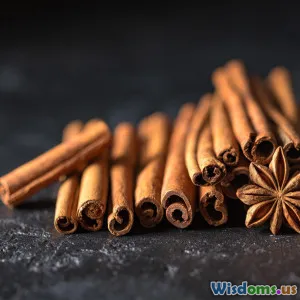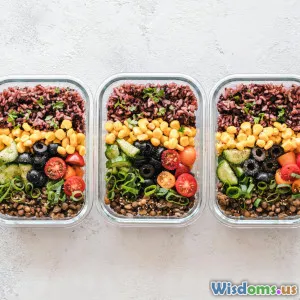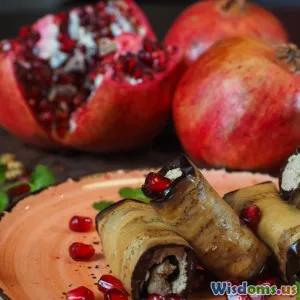
Why Sage Makes Roasts Unforgettable
8 min read Discover how sage transforms roasts into memorable culinary delights with its distinctive aroma, flavor chemistry, and rich culinary history. (0 Reviews)
Why Sage Makes Roasts Unforgettable
Roasting meat is a tradition celebrated in kitchens worldwide, a culinary ritual that transforms simple cuts into savory masterpieces. But there's one herb that consistently stands out for its unparalleled ability to turn a good roast into an unforgettable one: sage. What is it about this humble herb that captivates our palates, elevating everything from turkey and chicken to pork and beef? Let’s journey into the captivating world of sage and discover why it makes roasts truly unforgettable.
The Aromatic Power of Sage
At first glance, sage might seem unassuming, but its powerful aroma tells a different story. Native to the Mediterranean and a staple in European cooking for centuries, sage possesses a complex scent characterized by a slightly peppery, woodsy, and minty fragrance. This distinctive aroma results from a unique blend of essential oils such as thujone, camphor, and cineole.
How Sage Aroma Influences Taste
Our sensory experience of food relies heavily on aroma. In roasts, sage doesn’t just add flavor—it interplays with the meat’s fat to release volatile compounds that enhance the perception of richness and depth. Research in food science has shown that herbal aromatics like those in sage trigger olfactory receptors that accentuate savory notes, making the roast seem juicier and more flavorful.
For instance, experimental tastings comparing roasted pork with and without sage consistently reveal a preference for the sage-infused version, with tasters highlighting its "warmth" and "earthiness."
The Flavor Chemistry Behind Sage’s Magic
Sage contains a spectrum of chemical compounds that interact not just with our taste buds but also with the meat itself during cooking. The herb's phenolic acids and flavonoids have antioxidant properties that significantly affect the roast.
Antioxidants Aid in Flavor Preservation
During roasting, fats in the meat oxidize, which can lead to rancid or off flavors. Sage's antioxidants counterbalance this by neutralizing free radicals, preserving the integrity of the fat and thus enhancing the meat's natural savory profile.
This is why sage pairs so beautifully with fatty cuts of pork or rich poultry; it prevents overwhelming greasiness and adds a balanced freshness.
Flavor Layering and Complexity
Sage’s subtle bitterness and resinous notes complement the caramelization that occurs on the roast’s surface, known as the Maillard reaction. This reaction creates a rich, toasted flavor, and sage’s presence adds herbal complexity without overshadowing the meat.
If we look at classical recipes—like the traditional Italian porchetta or the British Sunday roast—sage often appears as a key ingredient because it seamlessly works with the meat’s natural flavors.
Sage’s Role in Culinary History and Tradition
Sage’s reputation is not just founded on modern food science, but steeped deeply in tradition. The herb has long been associated with wisdom—its Latin name, Salvia, derived from salvare, meaning "to save" or "heal." This notion of restorative power historically underscored its culinary use.
Cultural Significance Enhances the Experience
In many cultures, roasts flavored with sage are a symbol of celebration and comfort. In the United States, sage-seasoned turkey is central to Thanksgiving dinner, evoking feelings of warmth and family.
In Greece, sage-adorned lamb roasts mark festive occasions, while in France, its fragrant presence in herbes de Provence mixes brings a signature flavor to roasted meats. The shared cultural heritage gives sage-infused roasts an added emotional resonance, making every bite more memorable.
Expert Tips for Using Sage in Roasts
Fresh Versus Dried: Which One to Use?
Both fresh and dried sage have their pros and cons. Fresh sage leaves are prized for their vibrant aroma and subtle flavor; they can be tucked under skin or used as a bed for roasting. Dried sage, meanwhile, offers a more concentrated and slightly harsher flavor, great for rubs and seasoning blends.
How Much Sage Is Too Much?
Due to its potency, overuse of sage can produce a bitter or medicinal taste. Typically, a teaspoon of dried sage per pound of meat or 4-5 fresh leaves is ideal. Balancing sage with complementary herbs like rosemary, thyme, or garlic can also broaden flavor complexity.
Infusing Sage Through Cooking Techniques
- Herb butter: Mixing chopped sage with butter and slathering it under roast skin helps infuse flavor gradually.
- Sage oil or syrup: Infusing oil or syrup with sage can be brushed on meat before roasting.
- Stuffing and basting: Using sage within stuffing or basting liquids allows the herb's flavor to permeate the meat more deeply as it cooks.
Real-World Success Stories
Professional chefs and home cooks alike swear by sage:
- Chef Thomas Keller, renowned for his meticulous roasting technique, frequently incorporates fresh sage to add earthy nuance to poultry roasts.
- Home cooks surveyed by Food52 often cite sage as the single herb that "defines" their best pork roast recipes.
In food competitions and judges’ tastings, dishes using sage routinely score higher for aroma and complexity, validating its esteemed culinary status.
Conclusion: Sage as the Heart of Unforgettable Roasts
The secret to an unforgettable roast is found in the layers of flavor, aroma, and cultural resonance—a triumvirate where sage excels. Through its unique aromatic compounds, chemical interaction with roast fat, antioxidant benefits, and rich historical uses, sage transforms meat from merely cooked protein to a sensory experience.
By mastering the use of sage, cooks at every level can elevate their roasting game, ensuring that every dinner is not just delicious, but memorable. So next time you prepare a roast, let sage guide you—not only to flavor but to tradition, history, and unforgettable taste.
Embrace sage, and your roast will become more than a meal; it will become an event to savor long after the last bite.
Rate the Post
User Reviews
Other posts in Cooking with Herbs & Spices
Popular Posts

















